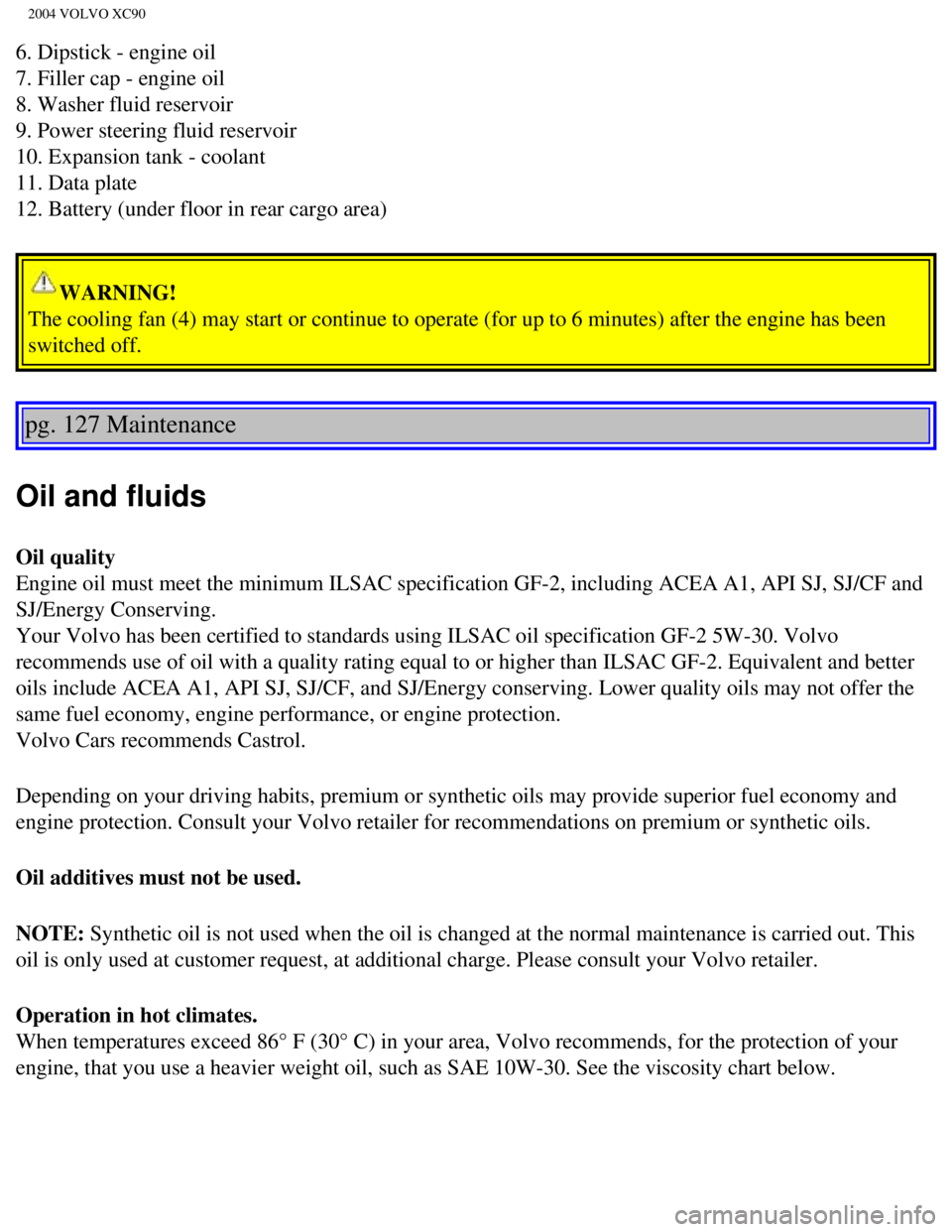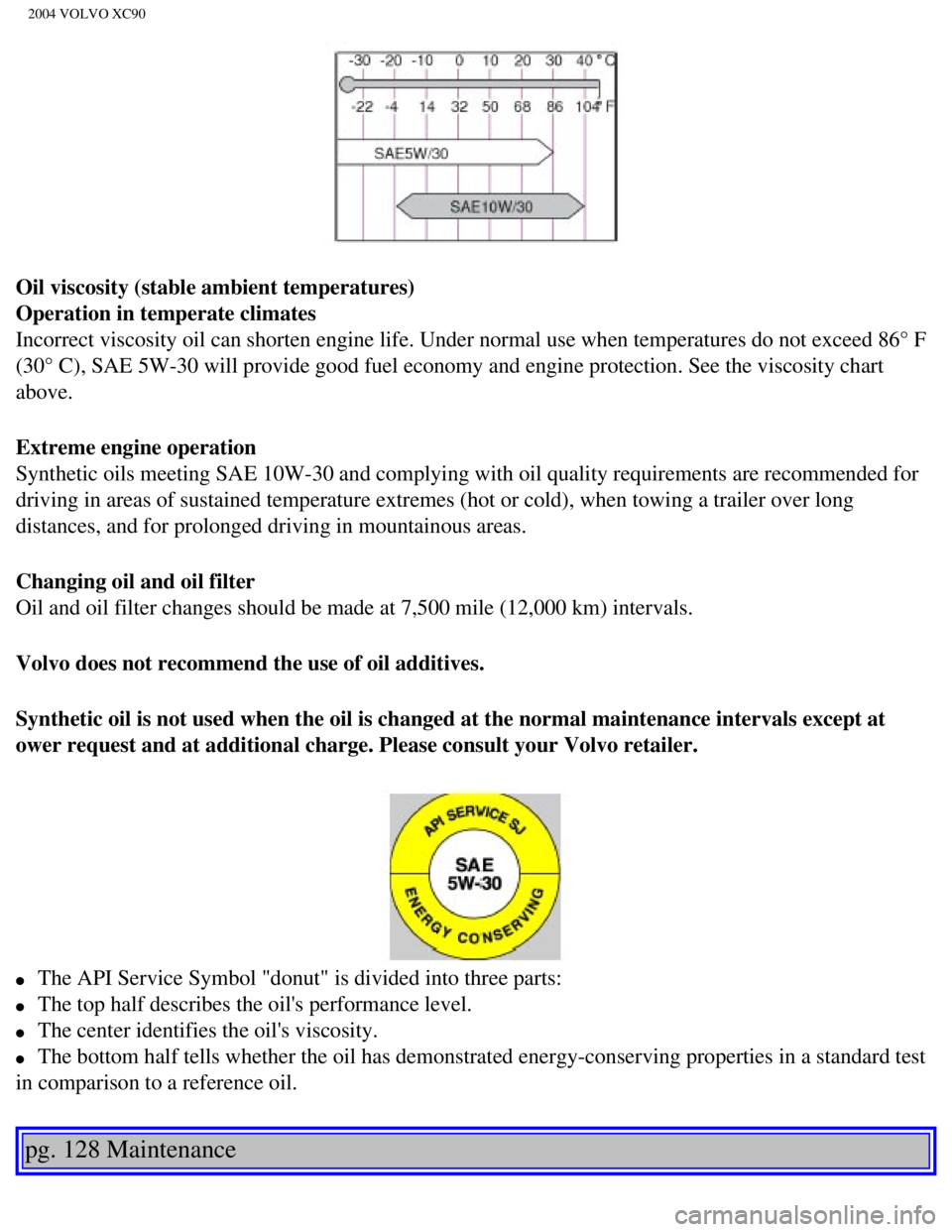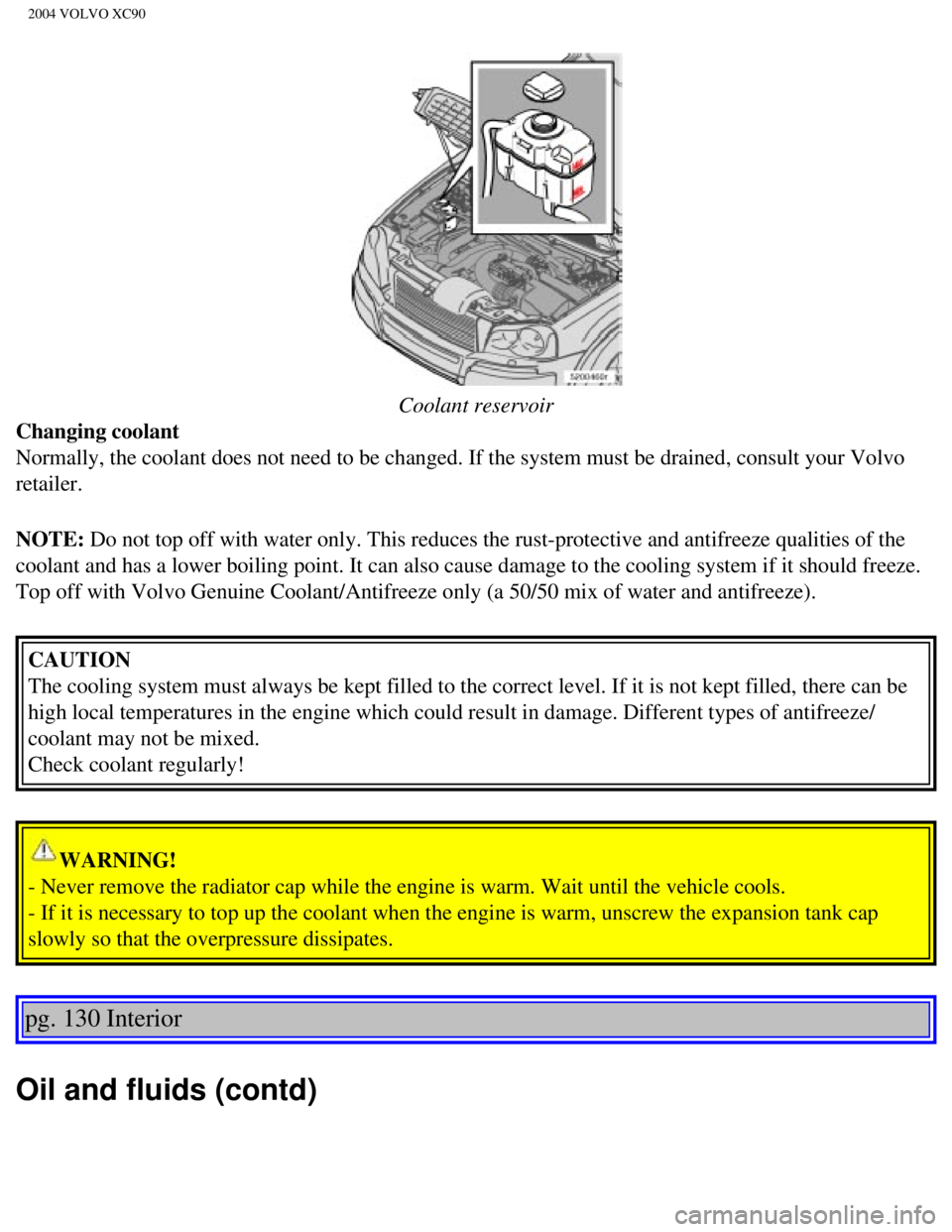2004 VOLVO XC90 oil temperature
[x] Cancel search: oil temperaturePage 112 of 245

2004 VOLVO XC90
starter to operate for up to 10 seconds. Release the key as soon as the \
engine starts. If the engine fails to
start, repeat this step.
NOTE:
- On certain models, when the vehicle is started, idle speed may be noti\
ceably higher than normal for a
short period, depending on the temperature of the engine.
This has been done to help bring components in the emission control syst\
em to their normal operating
temperature as quickly as possible, which enables them to function norma\
lly.
- For cold starts at altitudes above 6000 ft (1800 meters), depress th\
e accelerator pedal halfway and turn
the key to the starting position. Release the pedal slowly when the engi\
ne starts.
4. To release the gear selector from the (P)ark position, the engine must be running (or the ignition key
must be in position II) and the brake pedal must be depressed.
5. Select the desired gear. The gear engages after a very slight delay w\
hich is especially noticeable when
selecting R.
NOTE: Your vehicle is equipped with a Keylock system. When the engine is switc\
hed off, the gear
selector must be in the (P)ark position before the key can be removed \
from the ignition switch.
When starting in cold weather, the transmission may shift up at slightly\
higher engine speeds than
normal until the automatic transmission fluid reaches normal operating t\
emperature.
Do not race a cold engine immediately after starting. Oil flow may not r\
each some lubrication points fast
enough to prevent engine damage.
* If two of the keys to your vehicle are close together, e.g., on the sa\
me key ring, when you try to start
the vehicle, this could cause interference in the immobilizer system and\
result in the vehicle not starting.
If this should occur, remove one of the keys from the key ring before tr\
ying to start the vehicle again. CAUTION
Automatic transmission
The engine should be idling when you move the gear selector. Never accel\
erate until after you feel
the transmission engage! Accelerating immediately after selecting a gear\
will cause harsh engagement
and premature transmission wear.
Selecting P or N when idling at a standstill for prolonged periods of time will help pre\
vent
overheating of the automatic transmission fluid.
file:///K|/ownersdocs/2004/2004_XC90/04xc90_06a.htm (6 of 15)12/30/200\
6 4:35:22 PM
Page 136 of 245

2004 VOLVO XC90
Make sure that the load carrier is pressed firmly out against the roof r\
ail. Screw the load carrier in place.
Use the supplied torque wrench and tighten to the mark on the wrench (c\
orresponding to 6 Nm). See
illustration.
Load carrier cover
The vehicle's ignition key or the stud on the edge of the supplied torqu\
e wrench can be used to undo or
tighten the cover. Turn a quarter turn (90 degrees). See illustration.\
pg. 105 Starting and driving
Cold weather precautions
If you wish to check your vehicle before the approach of cold weather, t\
he following advice is worth
noting:
l Make sure that the engine coolant contains 50 percent antifreeze. Any ot\
her mixture will reduce
freeze protection. This gives protection against freezing down to -31°\
F (-35°C). See section "Coolant".
The use of "recycled" antifreeze is not approved by Volvo. Different typ\
es of antifreeze must not
be mixed.
l Volvo recommends using only genuine Volvo antifreeze in your vehicle's r\
adiator. Your Volvo
retailer stocks plenty of Volvo engine coolant to help protect your vehi\
cle during cold weather.
l Try to keep the fuel tank well filled - this prevents the formation of condensation in the tank. \
In
addition, in extremely cold weather conditions it is worthwhile to add f\
uel line de-icer before refueling.
l The viscosity of the engine oil is important. Oil with low viscosity (thinner oil) improves cold-
weather starting as well as decreasing fuel consumption while the engine\
is warming up. For winter use,
5W-30 oil, particularly the synthetic type*, is recommended. Be sure to \
use good quality oil but do not
use cold-weather oil for hard driving or in warm weather. See section "E\
ngine oil" for more information.
l The load placed on the battery is greater during the winter since the windshield wipers, lighting, etc\
.
are used more often. Moreover, the capacity of the battery decreases as \
the temperature drops. In very
cold weather, a poorly charged battery can freeze and be damaged. It is \
therefore advisable to check the
file:///K|/ownersdocs/2004/2004_XC90/04xc90_06b.htm (15 of 17)12/30/20\
06 4:35:23 PM
Page 162 of 245

2004 VOLVO XC90
Normally, the coolant does not need to be changed. If the system must be\
drained, consult your Volvo
retailer.
NOTE: Do not top off with water only. This reduces the rust-protective and ant\
ifreeze qualities of the
coolant and has a lower boiling point. It can also cause damage to the c\
ooling system if it should freeze.
Top off with Volvo Genuine Coolant/Antifreeze only (a 50/50 mix of wate\
r and antifreeze). CAUTION
The cooling system must always be kept filled to the correct level. If i\
t is not kept filled, there can be
high local temperatures in the engine which could result in damage. Diff\
erent types of antifreeze/
coolant may not be mixed.
WARNING!
Never remove the radiator cap while the engine is warm. Wait until the v\
ehicle
cools.
pg. 126 Maintenance
Engine compartment
Engine compartment
1. Brake fluid reservoir
2. Relay/fuse box
3. Air cleaner
4. Cooling fan
5. Radiator
file:///K|/ownersdocs/2004/2004_XC90/04xc90_09a.htm (6 of 14)12/30/200\
6 4:35:26 PM
Page 163 of 245

2004 VOLVO XC90
6. Dipstick - engine oil
7. Filler cap - engine oil
8. Washer fluid reservoir
9. Power steering fluid reservoir
10. Expansion tank - coolant
11. Data plate
12. Battery (under floor in rear cargo area)
WARNING!
The cooling fan (4) may start or continue to operate (for up to 6 min\
utes) after the engine has been
switched off.
pg. 127 Maintenance
Oil and fluids
Oil quality
Engine oil must meet the minimum ILSAC specification GF-2, including ACE\
A A1, API SJ, SJ/CF and
SJ/Energy Conserving.
Your Volvo has been certified to standards using ILSAC oil specification\
GF-2 5W-30. Volvo
recommends use of oil with a quality rating equal to or higher than ILSA\
C GF-2. Equivalent and better
oils include ACEA A1, API SJ, SJ/CF, and SJ/Energy conserving. Lower qua\
lity oils may not offer the
same fuel economy, engine performance, or engine protection.
Volvo Cars recommends Castrol.
Depending on your driving habits, premium or synthetic oils may provide \
superior fuel economy and
engine protection. Consult your Volvo retailer for recommendations on pr\
emium or synthetic oils.
Oil additives must not be used.
NOTE: Synthetic oil is not used when the oil is changed at the normal maintena\
nce is carried out. This
oil is only used at customer request, at additional charge. Please consu\
lt your Volvo retailer.
Operation in hot climates.
When temperatures exceed 86° F (30° C) in your area, Volvo recom\
mends, for the protection of your
engine, that you use a heavier weight oil, such as SAE 10W-30. See the v\
iscosity chart below.
file:///K|/ownersdocs/2004/2004_XC90/04xc90_09a.htm (7 of 14)12/30/200\
6 4:35:26 PM
Page 164 of 245

2004 VOLVO XC90
Oil viscosity (stable ambient temperatures)
Operation in temperate climates
Incorrect viscosity oil can shorten engine life. Under normal use when t\
emperatures do not exceed 86° F
(30° C), SAE 5W-30 will provide good fuel economy and engine protec\
tion. See the viscosity chart
above.
Extreme engine operation
Synthetic oils meeting SAE 10W-30 and complying with oil quality require\
ments are recommended for
driving in areas of sustained temperature extremes (hot or cold), when\
towing a trailer over long
distances, and for prolonged driving in mountainous areas.
Changing oil and oil filter
Oil and oil filter changes should be made at 7,500 mile (12,000 km) in\
tervals.
Volvo does not recommend the use of oil additives.
Synthetic oil is not used when the oil is changed at the normal maintena\
nce intervals except at
ower request and at additional charge. Please consult your Volvo retaile\
r.
l The API Service Symbol "donut" is divided into three parts:
l The top half describes the oil's performance level.
l The center identifies the oil's viscosity.
l The bottom half tells whether the oil has demonstrated energy-conserving\
properties in a standard test
in comparison to a reference oil.
pg. 128 Maintenance
file:///K|/ownersdocs/2004/2004_XC90/04xc90_09a.htm (8 of 14)12/30/200\
6 4:35:26 PM
Page 167 of 245

2004 VOLVO XC90
Coolant reservoir
Changing coolant
Normally, the coolant does not need to be changed. If the system must be\
drained, consult your Volvo
retailer.
NOTE: Do not top off with water only. This reduces the rust-protective and ant\
ifreeze qualities of the
coolant and has a lower boiling point. It can also cause damage to the c\
ooling system if it should freeze.
Top off with Volvo Genuine Coolant/Antifreeze only (a 50/50 mix of wate\
r and antifreeze).
CAUTION
The cooling system must always be kept filled to the correct level. If i\
t is not kept filled, there can be
high local temperatures in the engine which could result in damage. Diff\
erent types of antifreeze/
coolant may not be mixed.
Check coolant regularly!
WARNING!
- Never remove the radiator cap while the engine is warm. Wait until the\
vehicle cools.
- If it is necessary to top up the coolant when the engine is warm, unsc\
rew the expansion tank cap
slowly so that the overpressure dissipates.
pg. 130 Interior
Oil and fluids (contd)
file:///K|/ownersdocs/2004/2004_XC90/04xc90_09a.htm (11 of 14)12/30/20\
06 4:35:26 PM